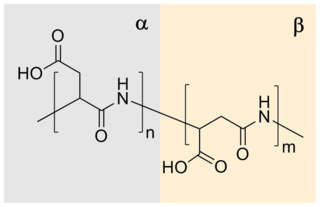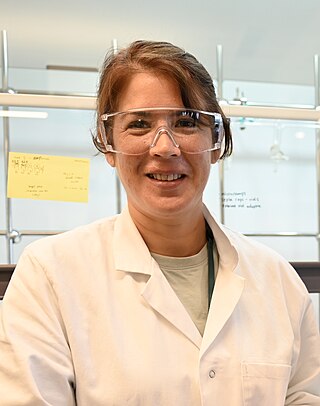Related Research Articles

The American Chemical Society (ACS) is a scientific society based in the United States that supports scientific inquiry in the field of chemistry. Founded in 1876 at New York University, the ACS currently has more than 155,000 members at all degree levels and in all fields of chemistry, chemical engineering, and related fields. It is one of the world's largest scientific societies by membership. The ACS is a 501(c)(3) non-profit organization and holds a congressional charter under Title 36 of the United States Code. Its headquarters are located in Washington, D.C., and it has a large concentration of staff in Columbus, Ohio.

Biodegradable plastics are plastics that can be decomposed by the action of living organisms, usually microbes, into water, carbon dioxide, and biomass. Biodegradable plastics are commonly produced with renewable raw materials, micro-organisms, petrochemicals, or combinations of all three.
Tobin Jay Marks is an inorganic chemistry Professor, the Vladimir N. Ipatieff Professor of Catalytic Chemistry, Professor of Material Science and Engineering, Professor of Chemical and Biological Engineering, and Professor of Applied Physics at Northwestern University in Evanston, Illinois. Among the themes of his research are synthetic organo-f-element and early-transition metal organometallic chemistry, polymer chemistry, materials chemistry, homogeneous and heterogeneous catalysis, molecule-based photonic materials, superconductivity, metal-organic chemical vapor deposition, and biological aspects of transition metal chemistry.

Krzysztof "Kris" Matyjaszewski is a Polish-American chemist. He is the J.C. Warner Professor of the Natural Sciences at the Carnegie Mellon University Matyjaszewski is best known for the discovery of atom transfer radical polymerization (ATRP), a novel method of polymer synthesis that has revolutionized the way macromolecules are made.

Kathryn Uhrich is Dean of the College of Natural and Agricultural Sciences, at The University of California, Riverside, and founder of Polymerix Corporation. She has received many awards for her research and work including the ACS Buck-Whitney Award and the Sioux Award. She was a fellow at both the National Academy of Inventors and the American Chemical Society in 2014.

JoAnne Stubbe is an American chemist best known for her work on ribonucleotide reductases, for which she was awarded the National Medal of Science in 2009. In 2017, she retired as a Professor of Chemistry and Biology at the Massachusetts Institute of Technology.
Laura Lee Kiessling is an American chemist and the Novartis Professor of Chemistry at the Massachusetts Institute of Technology. Kiessling's research focuses on elucidating and exploiting interactions on the cell surface, especially those mediated by proteins binding to carbohydrates. Multivalent protein-carbohydrate interactions play roles in cell-cell recognition and signal transduction. Understanding and manipulating these interactions provides tools to study biological processes and design therapeutic treatments. Kiessling's interdisciplinary research combines organic synthesis, polymer chemistry, structural biology, and molecular and cell biology.

Polyaspartic acid (PASA) is a biodegradable, water-soluble condensation polymer based on the amino acid aspartic acid. It is a biodegradable replacement for water softeners and related applications. PASA can be chemically crosslinked with a wide variety of methods to yield PASA hydrogels. The resulting hydrogels are pH-sensitive such that under acidic conditions, they shrink, while the swelling capacity increases under alkaline conditions.

Zhenan Bao is a Chinese-born American chemical engineer. She serves as K. K. Lee Professor of Chemical Engineering at Stanford University, with courtesy appointments in Chemistry and Material Science and Engineering. She served as the Department Chair of Chemical Engineering from 2018 to 2022. Bao is known for her work on organic field-effect transistors and organic semiconductors, for applications including flexible electronics and electronic skin.
Molly S. Shoichet, is a Canadian science professor, specializing in chemistry, biomaterials and biomedical engineering. She was Ontario's first Chief Scientist. Shoichet is a biomedical engineer known for her work in tissue engineering, and is the only person to be a fellow of the three National Academies in Canada.

Eugenia Eduardovna Kumacheva is a University Professor and Distinguished Professor of Chemistry at the University of Toronto. Her research interests span across the fields of fundamental and applied polymers science, nanotechnology, microfluidics, and interface chemistry. She was awarded the L'Oréal-UNESCO Awards for Women in Science in 2008 "for the design and development of new materials with many applications including targeted drug delivery for cancer treatments and materials for high density optical data storage". In 2011, she published a book on the Microfluidic Reactors for Polymer Particles co-authored with Piotr Garstecki. She is Canadian Research Chair in Advanced Polymer Materials. She is Fellow of the Royal Society (FRS) and a Fellow of the Royal Society of Canada (FRSC).
Julia Ann Kalow is an assistant professor of chemistry at Northwestern University. She is primarily a synthetic chemist, who works on polymers, photochemistry and tissue engineering. She is interested in synthetic strategies that can turn molecular structure and chemical reactivity into macroscopic properties. She has been awarded the National Science Foundation CAREER Award, Thieme Award and was selected by the University of Chicago as a Rising Star in Chemistry.
Theodore Goodson III is an American chemist who is the Richard Barry Bernstein Professor of Chemistry at the University of Michigan. Goodson studies the non-linear optical properties of novel organic materials. He was elected fellow of the American Association for the Advancement of Science in 2012 and the American Institute for Medical and Biological Engineering in 2021.
Emilie Ringe is an American chemist who is an assistant professor at the University of Cambridge. She was selected by Chemical & Engineering News as one of its "Talented Twelve" young scientists in 2021.

Christine Luscombe is a Japanese-British chemist who is a professor at the Okinawa Institute of Science and Technology. Her research investigates polymer chemistry, organic electronics, organic photovoltaics and the synthesis of novel materials for processable electronics. She serves on the editorial boards of Macromolecules, Advanced Functional Materials, the Annual Review of Materials Research and ACS Applied Materials & Interfaces.

Karena Chapman is an Australian chemist who is the Joseph W Lauher & Frank W Fowler Endowed Chair in Materials Chemistry at Stony Brook University. Her research considers the use of high energy X-rays to better understand the structure property relationships of energy materials.

Xiaodan Gu is the Nina Bell Suggs endowed professor of Polymer Science and Engineering at The University of Southern Mississippi. Since 2017, Gu has been a professor at Southern Miss where his research involves studying the physics and morphology of conjugated polymers.
Emily D. Cranston is a Canadian chemist who is a professor at the University of British Columbia and President’s Excellence Chair in Forest Bioproducts. She investigates nanocellulose and hybrid bio-based materials. Cranston is an NSERC E.W.R. Steacie fellow and was awarded the Kavli Emerging Leader in Chemistry lectureship in 2018 and the Tappi NanoDivision Technical Award in 2021.
Athina Anastasaki is a Greek chemist who is a professor at ETH Zurich. Her research considers chemical synthesis and radical polymerisation. She was awarded the 2022 Ruzicka Prize in recognition of her research in chemistry.
Alison Wendlandt is an American chemist who is an assistant professor at the Massachusetts Institute of Technology. Her research considers the development of catalysts for organic synthesis.
References
- ↑ "#IfThenSheCan – The Exhibit". ifthenexhibit.org. Retrieved August 4, 2022.
- 1 2 3 4 "Helen Tran: This polymer designer creates biocompatible, biodegradable materials for sensors". cen.acs.org. Retrieved July 25, 2022.
- 1 2 "Helen Tran selected for the Henzl-Gabor award and as an AAAS if/then ambassador | Bao Group". baogroup.stanford.edu. September 9, 2019. Retrieved July 25, 2022.
- 1 2 "| IF/THEN Collection". www.ifthencollection.org. Retrieved July 25, 2022.
- ↑ "Helen Tran receives 2021 Dorothy Shoichet Award". www.chemistry.utoronto.ca. December 8, 2021. Retrieved July 25, 2022.
- ↑ "C&EN's Talented 12". cen.acs.org. Retrieved July 25, 2022.
- ↑ "Helen Tran named one of Chemical & Engineering News' "Talented 12"". www.chemistry.utoronto.ca. July 18, 2022. Retrieved July 25, 2022.